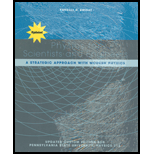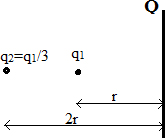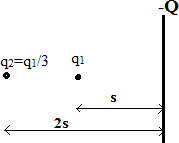
Concept explainers
a. Charge q1is distance r from a positive point charge Q. Charge q2= q1/3 is distance 2r from Q. What is the ratio U1/U2 of their potential energies due to their interactions with Q? b. Charge q1is distance s from the negative plate of a parallel-plate capacitor. Charge q2= q1/3 is distance 2s from the negative plate. What is the ratio U1/U2 of their potential energies?
a. Ratio of potential energy
b. Ratio of potential energy
Answer to Problem 1CQ
Solution:
a. Ratio of the potential energy is
b. Ratio of the potential energy is
Explanation of Solution
Given:
(a)
Charge
Charge
(b)
Charge
Charge
Formula used:
The potential energy of the charge particle is given by the formula
Here,
Calculation:
(a)
Consider the diagram of the charge particles

Figure.1
The potential energy of the charge particle
The potential energy of the charge particle
Plugging the values in the above equation
Calculate the ratio of the potential energy by dividing Eq. (1) by Eq. (2)
Hence the ration of their potential energy is
(b)
Consider the diagram of the charge particles

Figure.1
The potential energy of the charge particle
Plugging the values in the above equation
The potential energy of the charge particle
Plugging the values in the above equation
Calculate the ratio of the potential energy by dividing Eq. (3) by Eq. (4)
Hence the ration of their potential energy is
Conclusion:
a. Ratio of the potential energy is
b. Ratio of the potential energy is
Want to see more full solutions like this?
Chapter 25 Solutions
PHYS 212 FOR SCI+ENG W/MAST PHYS >ICP<
Additional Science Textbook Solutions
Concepts of Genetics (12th Edition)
Laboratory Experiments in Microbiology (12th Edition) (What's New in Microbiology)
Cosmic Perspective Fundamentals
The Cosmic Perspective (8th Edition)
Chemistry: An Introduction to General, Organic, and Biological Chemistry (13th Edition)
Human Anatomy & Physiology (2nd Edition)
- help me answer this with explanations! thanks so mucharrow_forwardNo chatgpt pls will upvote Alreadyarrow_forwardWhat fuel economy should be expected from a gasoline powered car that encounters a total of 443N of resistive forces while driving down the road? (Those forces are from air drag, rolling resistance and bearing losses.) Assume a 30% thermodynamic efficiency.arrow_forward
- No chatgpt pls will upvotearrow_forward12. What is the angle between two unit vectors if their dot product is 0.5?arrow_forwardIf the car in the previous problem increases its power output by 10% (by pressing the gas pedal farther down), at what rate will the car accelerate? Hint: Consider the net force. In the previous problem the power was 31.8kWarrow_forward
- What power is required (at the wheels) for a 1400 kg automobile to climb a 4% grade at a constant speed 30 m/s while it is opposed by drag and rolling resistance forces totaling 500 N?arrow_forwardNo chatgpt pls will upvotearrow_forwardAs a box is lifted against gravity and placed on a shelf, how does the work done by the lifter compare with the work done by gravity? What is the net work done on the box? What does this imply about its change in kinetic energy? Use definitions and mathematics from this chapter to answer these questions.arrow_forward
- As I carry a box up a flight of stairs, am I doing positive work or negative work on the box? Provide a mathematical explanation.arrow_forwardAs a ball falls under the influence of gravity, does gravity do positive work or negative work? Provide a mathematical explanation.arrow_forwardUnder what circumstances is it bad to describe kinetic energy as k = 1/2mv^2arrow_forward
 College PhysicsPhysicsISBN:9781938168000Author:Paul Peter Urone, Roger HinrichsPublisher:OpenStax College
College PhysicsPhysicsISBN:9781938168000Author:Paul Peter Urone, Roger HinrichsPublisher:OpenStax College Physics for Scientists and Engineers, Technology ...PhysicsISBN:9781305116399Author:Raymond A. Serway, John W. JewettPublisher:Cengage Learning
Physics for Scientists and Engineers, Technology ...PhysicsISBN:9781305116399Author:Raymond A. Serway, John W. JewettPublisher:Cengage Learning
 College PhysicsPhysicsISBN:9781285737027Author:Raymond A. Serway, Chris VuillePublisher:Cengage Learning
College PhysicsPhysicsISBN:9781285737027Author:Raymond A. Serway, Chris VuillePublisher:Cengage Learning Physics for Scientists and Engineers: Foundations...PhysicsISBN:9781133939146Author:Katz, Debora M.Publisher:Cengage Learning
Physics for Scientists and Engineers: Foundations...PhysicsISBN:9781133939146Author:Katz, Debora M.Publisher:Cengage Learning College PhysicsPhysicsISBN:9781305952300Author:Raymond A. Serway, Chris VuillePublisher:Cengage Learning
College PhysicsPhysicsISBN:9781305952300Author:Raymond A. Serway, Chris VuillePublisher:Cengage Learning





